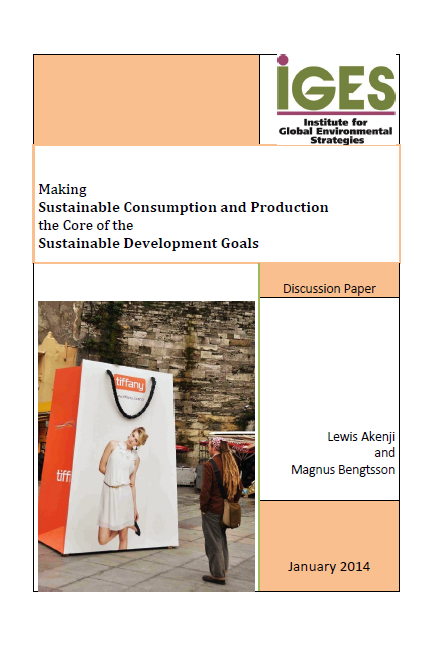
Making Sustainable Consumption and Production the Core of the
Sustainable Development Goals
Lewis Akenji and Magnus Bengtsson
Background
Governments gathered at the Rio+20 meeting in 2012 agreed to develop a set of goals that would unify efforts and concretize actions towards sustainable development – the Sustainable Development Goals (SDGs). In parallel, discussions have been held on how to design an international framework to follow-up on the Millennium Development Goals (MDGs) when they expire in 2015. Recently it has been decided that these two efforts will be merged into a common SDGs and post-2015 MDGs agenda.
Unsustainable patterns of consumption and production have been declared the primary cause of environmental deterioration. This was clearly recognized already at the United Nations Conference on Environment and Development (UNCED, or the Rio Summit) in 1992, and this recognition has been reconfirmed in all high-level sustainability meetings since then. Sustainable Consumption and Production (SCP) aims to change these patterns; it is thus a policy agenda for addressing the root causes of our ecological predicament while at the same time providing for human well-being and prosperity.
This paper argues that SCP should be reflected in the formulation and implementation of the SDGs. Drawing from international agreements, practical policy experience, and research from a range of disciplines, the intention of this paper is to provide a clarifying framework for scientifically robust, policy relevant and practical goal-setting for SCP within the SDGs. Special attention is given to how SCP in the SDGs can create synergies with other international policy initiatives. The paper highlights two possible options: i) SCP as a stand-alone goal, and ii) SCP as a cross-cutting objective embedded within relevant goals. While the two are not necessarily mutually exclusive, given the competing number of issues for prioritization and the fact that there is also a 10-Year Framework of Programmes on SCP, it is hardly foreseeable that both options can be reflected. Thus the advantages and disadvantages of each of the two options are analysed and discussed. Some basic principles for SCP at a global level are presented, and some recommendations are provided towards the formulation of indicators supporting SCP objectives in the SDGs.


































